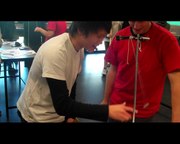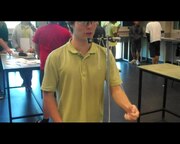Measurement
Contents
Introduction to measurements
Accuracy improving techniques
Repeat and average
To improve the accuracy of the investigation datas, repeating the trials for number of times and averaging needs to be done. The method to conduct this technique is very simple. Do the trial for number of times such as 5times and average the result out. For example, in this Bridge Swing investigation. The trials can be repeated 5 times. The results I got for 70cm length (ten oscillations) were
- 18.0sec
- 17.2sec
- 17.5sec
- 17.5sec
- 17.4sec
Make sure that times are recorded to one decimal place.
Now, these results can be averaged by adding all the results and dividing by the number of trials done.
In this case, (18.0 + 17.2 + 17.5 + 17.5 + 17.4) / 5
Which gives us 17.5 sec(again make sure the time is recorded to one decimal place).
This way we can make the data more confident as we can mean out all some of the random errors.
Choice of scale
To achieve a more accurate scale, when measuring a length or a distance, it is better to use a tool that can measure in the smallest possible scale. For example, we would use the mm side of a metre ruler compared to the cm side. This allows us to be more accurate. You need to choose a scale that is relevant to what you are measuring. You wouldn't measure the north island in mm, and you wouldn't measure your height in KM.
Multiple measurements
We recored multiple periods for oscaliations and repeated the experment multiple times to get a more accurate measurement. The experiment was to show accuracy improving techniques on a simple pendulum experiment. We improved the accuracy of the results of this experiment by taking multiple measurements.
For the example above the average time for ten oscillations was 17.5 seconds. To find the time for one oscillation we divide 17.5 by 10 and get an answer of 1.75 seconds. Notice that we can now give the time to two decimal places (if we had only timed one oscillation we could only read the time from the stopwatch to one decimal place).
Zero error reduction
Parallax error reduction
Parallax error occurs when the scale of the measuring intstrument is not in contact with the object being measured. This creates a gap between the scale markings and the object and can cause parallax error. To prevent or reduce parallax error, the person who takes the measurement must be looking at the scale directly from above, perpendicular to the measuring instrument, to make the reading accurate.
Number of significant figures to use
For timing:
1 decimal place.
When using an instrument with a scale:
Measure to the nearest division on the scale.
E.g. if using a metre ruler with millimetre divisions, measure to the nearest millimetre.
Uncertainties in measurements
Timing- work out the range of measurements, your uncertainty is half the range.
e.g. 12.5, 13.2, 11.8, 12.3, 11.5....
- average = 12.3 (round to 1dp)
- range = 1.7
- half range = 0.85
- = 0.9 (round to 1sf)
- 12.3 +/- 0.9 <-----(absolute uncertainty always use 1sf)
Processing uncertainties
Planning an experiment
Independent variable
The Independent variable is the variable that I change during an experiment. It is the thing we are investigating to see if it has an effect on something else.
Dependent variable
The Dependent variable is dependent upon what I do to it when I change the independent variable. In other words, it is what changes as a result of me changing the independent variable.






